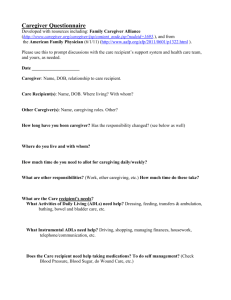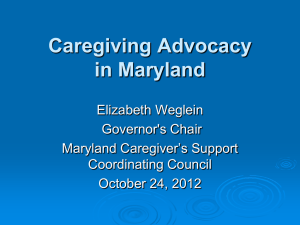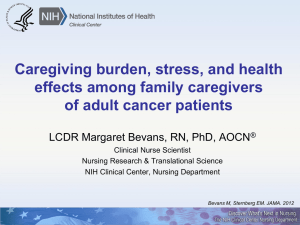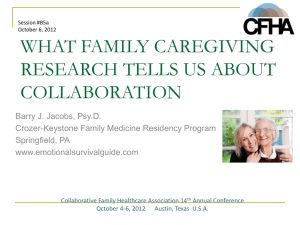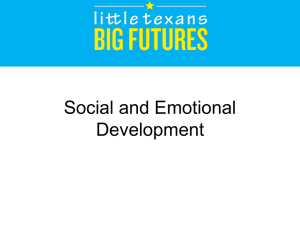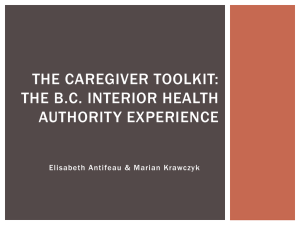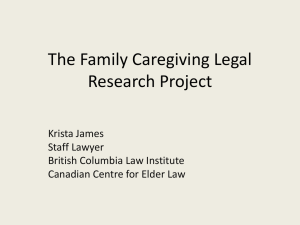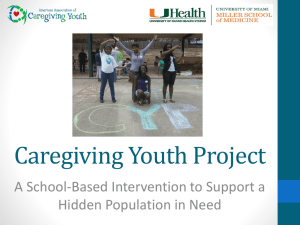Styles-GW-Poster
advertisement
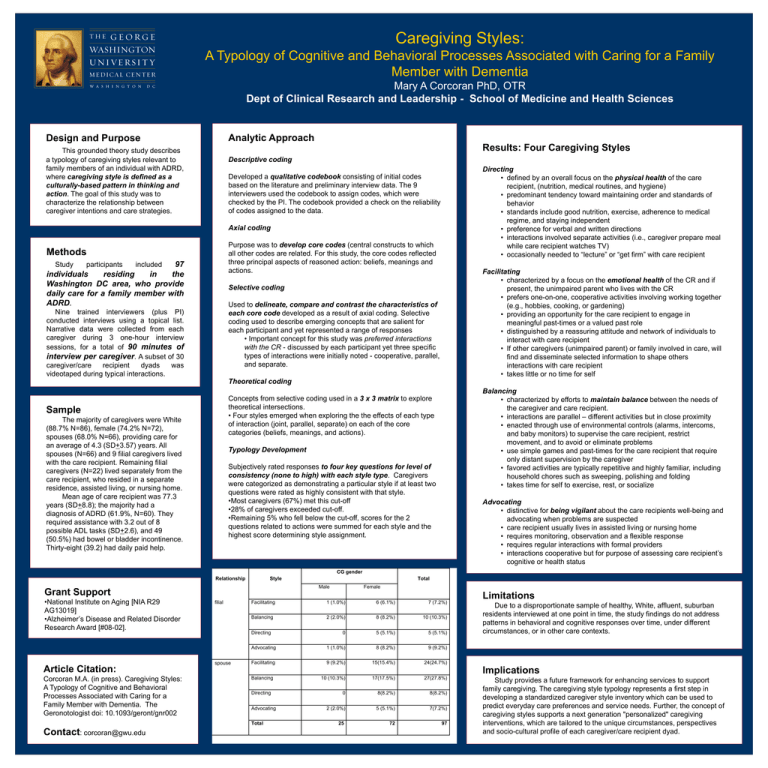
Caregiving Styles: A Typology of Cognitive and Behavioral Processes Associated with Caring for a Family Member with Dementia Mary A Corcoran PhD, OTR Dept of Clinical Research and Leadership - School of Medicine and Health Sciences Design and Purpose This grounded theory study describes a typology of caregiving styles relevant to family members of an individual with ADRD, where caregiving style is defined as a culturally-based pattern in thinking and action. The goal of this study was to characterize the relationship between caregiver intentions and care strategies. Analytic Approach Results: Four Caregiving Styles Descriptive coding Developed a qualitative codebook consisting of initial codes based on the literature and preliminary interview data. The 9 interviewers used the codebook to assign codes, which were checked by the PI. The codebook provided a check on the reliability of codes assigned to the data. Axial coding Methods 97 individuals residing in the Washington DC area, who provide daily care for a family member with ADRD. Study participants included Nine trained interviewers (plus PI) conducted interviews using a topical list. Narrative data were collected from each caregiver during 3 one-hour interview sessions, for a total of 90 minutes of interview per caregiver. A subset of 30 caregiver/care recipient dyads was videotaped during typical interactions. Purpose was to develop core codes (central constructs to which all other codes are related. For this study, the core codes reflected three principal aspects of reasoned action: beliefs, meanings and actions. Selective coding Used to delineate, compare and contrast the characteristics of each core code developed as a result of axial coding. Selective coding used to describe emerging concepts that are salient for each participant and yet represented a range of responses • Important concept for this study was preferred interactions with the CR - discussed by each participant yet three specific types of interactions were initially noted - cooperative, parallel, and separate. Directing • defined by an overall focus on the physical health of the care recipient, (nutrition, medical routines, and hygiene) • predominant tendency toward maintaining order and standards of behavior • standards include good nutrition, exercise, adherence to medical regime, and staying independent • preference for verbal and written directions • interactions involved separate activities (i.e., caregiver prepare meal while care recipient watches TV) • occasionally needed to “lecture” or “get firm” with care recipient Facilitating • characterized by a focus on the emotional health of the CR and if present, the unimpaired parent who lives with the CR • prefers one-on-one, cooperative activities involving working together (e.g., hobbies, cooking, or gardening) • providing an opportunity for the care recipient to engage in meaningful past-times or a valued past role • distinguished by a reassuring attitude and network of individuals to interact with care recipient • If other caregivers (unimpaired parent) or family involved in care, will find and disseminate selected information to shape others interactions with care recipient • takes little or no time for self Theoretical coding Sample The majority of caregivers were White (88.7% N=86), female (74.2% N=72), spouses (68.0% N=66), providing care for an average of 4.3 (SD+3.57) years. All spouses (N=66) and 9 filial caregivers lived with the care recipient. Remaining filial caregivers (N=22) lived separately from the care recipient, who resided in a separate residence, assisted living, or nursing home. Mean age of care recipient was 77.3 years (SD+8.8); the majority had a diagnosis of ADRD (61.9%, N=60). They required assistance with 3.2 out of 8 possible ADL tasks (SD+2.6), and 49 (50.5%) had bowel or bladder incontinence. Thirty-eight (39.2) had daily paid help. Grant Support •National Institute on Aging [NIA R29 AG13019] •Alzheimer’s Disease and Related Disorder Research Award [#08-02]. Concepts from selective coding used in a 3 x 3 matrix to explore theoretical intersections. • Four styles emerged when exploring the the effects of each type of interaction (joint, parallel, separate) on each of the core categories (beliefs, meanings, and actions). Typology Development Subjectively rated responses to four key questions for level of consistency (none to high) with each style type. Caregivers were categorized as demonstrating a particular style if at least two questions were rated as highly consistent with that style. •Most caregivers (67%) met this cut-off •28% of caregivers exceeded cut-off. •Remaining 5% who fell below the cut-off, scores for the 2 questions related to actions were summed for each style and the highest score determining style assignment. Balancing • characterized by efforts to maintain balance between the needs of the caregiver and care recipient. • interactions are parallel – different activities but in close proximity • enacted through use of environmental controls (alarms, intercoms, and baby monitors) to supervise the care recipient, restrict movement, and to avoid or eliminate problems • use simple games and past-times for the care recipient that require only distant supervision by the caregiver • favored activities are typically repetitive and highly familiar, including household chores such as sweeping, polishing and folding • takes time for self to exercise, rest, or socialize Advocating • distinctive for being vigilant about the care recipients well-being and advocating when problems are suspected • care recipient usually lives in assisted living or nursing home • requires monitoring, observation and a flexible response • requires regular interactions with formal providers • interactions cooperative but for purpose of assessing care recipient’s cognitive or health status Limitations Due to a disproportionate sample of healthy, White, affluent, suburban residents interviewed at one point in time, the study findings do not address patterns in behavioral and cognitive responses over time, under different circumstances, or in other care contexts. Article Citation: Implications Corcoran M.A. (in press). Caregiving Styles: A Typology of Cognitive and Behavioral Processes Associated with Caring for a Family Member with Dementia. The Geronotologist doi: 10.1093/geront/gnr002 Study provides a future framework for enhancing services to support family caregiving. The caregiving style typology represents a first step in developing a standardized caregiver style inventory which can be used to predict everyday care preferences and service needs. Further, the concept of caregiving styles supports a next generation "personalized" caregiving interventions, which are tailored to the unique circumstances, perspectives and socio-cultural profile of each caregiver/care recipient dyad. Contact: corcoran@gwu.edu

